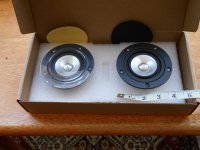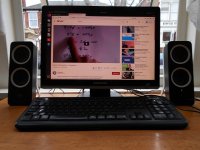If you sell these and don't listen to them yourself for at least several months you will not have learned much from building them.
In all likelihood they will sound very good to you at first. Particularly if you play some of your favorite music and it has been recorded fairly well. But you won't hear the flaws at first.
But if you keep listening to them eventually the flaws will become apparent. And there will be flaws.
And from there you can determine what to do differently in your next build. Without that listening experience you are essentially starting all over again from scratch with your next build and the results are likely to be disappointing compared to what they would be if you had spent more time listening to your first one.
In all likelihood they will sound very good to you at first. Particularly if you play some of your favorite music and it has been recorded fairly well. But you won't hear the flaws at first.
But if you keep listening to them eventually the flaws will become apparent. And there will be flaws.
And from there you can determine what to do differently in your next build. Without that listening experience you are essentially starting all over again from scratch with your next build and the results are likely to be disappointing compared to what they would be if you had spent more time listening to your first one.
ive done my first attempt on vituix, adding the resistor did help with giving me 6ohms impedance but can someone please help me move the crossover point? its way too low, i cant get the tweeter to move further up the frequencies without lowering the value of the resistor,
im also not sure if the 7mm z offset is on the right driver or if its the right value, it should be 0.7 according to xsim but im not sure how that converts to vituix
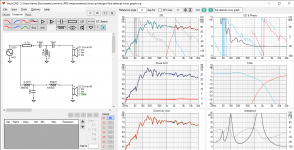
im also not sure if the 7mm z offset is on the right driver or if its the right value, it should be 0.7 according to xsim but im not sure how that converts to vituix

If you sell these and don't listen to them yourself for at least several months you will not have learned much from building them.
In all likelihood they will sound very good to you at first. Particularly if you play some of your favorite music and it has been recorded fairly well. But you won't hear the flaws at first.
But if you keep listening to them eventually the flaws will become apparent. And there will be flaws.
And from there you can determine what to do differently in your next build. Without that listening experience you are essentially starting all over again from scratch with your next build and the results are likely to be disappointing compared to what they would be if you had spent more time listening to your first one.
Yes i completely understand where your coming from, i have made 5 of these speakers, for use as 'large' surround sound speakers, if the guy wants to buy some it will only be two of them, as i intend to replace those by building a tv cabinet with built in speakers in the future, so ill have 3 left to listen to and learn from. At the moment ive listened to them for about 5 months, just without the tweeter connected and so far i do actually like how they sound, but once the crossover and tweeter are added i might have a different opinion, if they ever get added that is 😄
Dameo182,
Floyd Toole's book is not going to help you at your level. It is not easy to read and deals more with sound perception and room issues than with basic speaker design. I can sum it up in one sentence for you:
Most people prefer speakers with a flat frequency response.
That's it. Four hundred and some pages later that is mainly what you will take away from it. It is more an academic study than a how-to-do-it guide.
For basic speaker design reading I would suggest starting with "Speaker Building 201" by Ray Alden. It's very readable and much more oriented to what you are dealing with at the moment.
Hi classicalfan,
you should expand on that summary. Flat frequency response means what? at listening position? what does it mean in the measurements? 🙂
For a beginner it is easy to read that as if "flat on axis frequency response is enough" when in fact there is a lot more to it, and Dameo182 is trying to figure that out.
As academic study the book is good information. It doesn't hurt to make a quick look to that book. I have found that large amount of data is easier to tackle by looking at it quickly from different perspectives, and then try to drill down to the next level at point that feels relevant/natural.
If the "Speaker building 201" feels good by all means read it first. I think books in general are more suitable for beginners than an online discussion group anyway 🙂
Ill read both 🙂 in fact i need to read everything i can because im struggling with a basic mtm speaker lol
ive done my first attempt on vituix, adding the resistor did help with giving me 6ohms impedance but can someone please help me move the crossover point? its way too low, i cant get the tweeter to move further up the frequencies without lowering the value of the resistor,
im also not sure if the 7mm z offset is on the right driver or if its the right value, it should be 0.7 according to xsim but im not sure how that converts to vituix
View attachment 934292
To take full advantage of the program read the measurement guide, the power comes from the "spinorama" measurements. VituixCAD Loudspeaker simulator
Google what is spinorama. Find out what power response means and what is directivity index, what is Harman curve, how these relate to each other? There is a lot more, but this is something the VituixCAD enables you to measure and simulate at home. These suggestions are just to get some foot hold where you can start to find your own path. You can take a simpler one and just measure on axis, or might as well do it properly if you feel like it 🙂
Last edited:
Thank you, ill google it, i read the measurement part of the guide earlier but will give it another read, im a fabricator for a reason though, im not that clever with stuff that doesnt need welding, yet lol
Last edited:
I need to add that the reason I'm trying to get you take proper measurements is that it is the only way to get proper crossover simulation. Of course you could do it with simple on-axis messurements only but that doesn't reflect the sound you hear or measure at the listening position so there really is not too much value into it. Some experienced designers might know what they are doing and get away with simple quick measurements but even they would benefit from the full spinorama set I bet. Flat on axis response in simulator can be achieved in million different ways, but if you have the off axis data you'll be able to sort out which of the million ways are poop and which are good. Tooles book have images of the good and bad stuff I believe.
Edit. gotta add that spinorama won't show what the sound is at listening position either because the room is not included but it is a lot more accurate than on axis measurement alone. VituixCAD can simulate effect of the room boundaries as well.
Edit. gotta add that spinorama won't show what the sound is at listening position either because the room is not included but it is a lot more accurate than on axis measurement alone. VituixCAD can simulate effect of the room boundaries as well.
Last edited:
Yeah i understand, i just at the moment find it very confusing, i watched the video on youtube about how to add off axis measurements and it just didnt sink in at all with so many processes, i know ill get there eventually im just dreading the climb
I have great respect for the folks who regularly post here, however I remember talking with a neurosurgeon who believed that brain surgery was simple and said," A highly trained gorilla could do what I do." There are people I know who have been building speakers for many years who have never been able to develop more than marginal to fair skills designing speakers. I am one of them.
The only thing that was able to get me over the hump to where I can design and build a "decent" speaker was to get an expert to sit down with me and go step by step through the process, with me asking questions and taking notes as we went along. He primarily uses Jeff Bagby's WinPCD himself, but we found that Xsim (which he also uses) was MUCH more intuitive and productive for me.
I have a Ph.D., read all the books suggested to you, built over a dozen pairs of speakers, had all the suggested software but was still a total loss at designing a good crossover for a simple two way. Innate talent and a good background in the material one is atempting to master make a big difference in skill aquisition. I have very little of either and I needed one on one "hands on" tutoring to avoid giving up in frustration.
Just one persons thoughts about the issues you are wrestling with.
Best,
Jay
The only thing that was able to get me over the hump to where I can design and build a "decent" speaker was to get an expert to sit down with me and go step by step through the process, with me asking questions and taking notes as we went along. He primarily uses Jeff Bagby's WinPCD himself, but we found that Xsim (which he also uses) was MUCH more intuitive and productive for me.
I have a Ph.D., read all the books suggested to you, built over a dozen pairs of speakers, had all the suggested software but was still a total loss at designing a good crossover for a simple two way. Innate talent and a good background in the material one is atempting to master make a big difference in skill aquisition. I have very little of either and I needed one on one "hands on" tutoring to avoid giving up in frustration.
Just one persons thoughts about the issues you are wrestling with.
Best,
Jay
Thats exactly what im afraid of, not having the mental ability to figure it out on my own, i dont really have much choice though since i have no one to help me. I want to carry on building because i love music and films and i enjoy the idea of the freedom to make my own audio stuff, Instead of having to pick from off the shelf crap that has 50% of its value in the badge its labelled with. But my uncle has a saying, that he related to astro physicists, 'its like a fly landing on an open book, it can see the words, but doesnt have the mental capacity to ever understand them' thats kinda how i feel about all the software needed to properly build a good speaker. Im gonna give it my best shot though, you never fail, you learn, i guess
I got the tutoring I needed by putting a post up on the Parts Express Tech Talk website asking if there was anyone within driving distance who had the necessary skills and was willing to sit down and teach me. I offered to pay, but my teacher said he enjoyed teaching and wouldn't accept any money. I'll bet something similar would work for you, there are tons of DIY audio guys in England.
Yeah maybe that could work, ill have to ask around and see if anyone is willing, for now im just messing about seeing what works, nothing ive done yet though has moved the crossover point in the right direction. May just wait for my new tweeter and have a fresh go at it
I've never looked into mtm speakers but I think I've read somewhere that D'appolito or similarly named person kind of made the mtm a thing, maybe a paper even? Not sure if every mtm should follow his "rules" but surely you could look some of his work or maybe some other mtm speakers that have published their driver and crossover data for inspiration.
I think the tweeter has to play really low, so if you are shopping new one check out why other mtm speakers have drivers they have. Might be your problem moving the crossover, tweeter just can't play that low? Too low a crossover point makes the tweeter distort, woofers on the other hand do not want the crossover too high due to their distance from each other and there might be some cone resonance issues to watch out for. Hope it helps 🙂
I think the tweeter has to play really low, so if you are shopping new one check out why other mtm speakers have drivers they have. Might be your problem moving the crossover, tweeter just can't play that low? Too low a crossover point makes the tweeter distort, woofers on the other hand do not want the crossover too high due to their distance from each other and there might be some cone resonance issues to watch out for. Hope it helps 🙂
Last edited:
Yeah thanks, the tweeters fs is 1650 so i really wanna be crossing over at around 45000 upwards but the response graph takes a beating when i do that, and the only way i can find to actually move the tweeter up the frequencies is to lower the inductor value, which has been mentioned to be too small already. So ive ordered a new tweeter with an fs of 1350, and m hoping that is easier to work with.
But yeah looking at other mtm build crossovers is a good idea, it might give me some inspiration
But yeah looking at other mtm build crossovers is a good idea, it might give me some inspiration
With respect, I think you are making this far more difficult than it is. 😀
What is hard about integrating a couple of flattish and low inductance 3" fullrangers with 3/4" 4 ohm tweeter?
It is going to look like this with an added 2.2R resistor right next to the tweeter to get the 4 ohm tweeter up to 6 ohms:
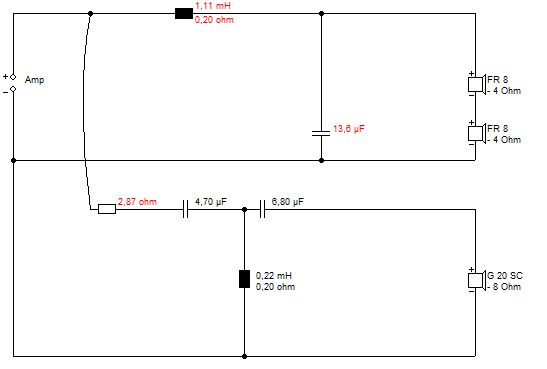
I showed you a typical way you to up a tweeters resistance:
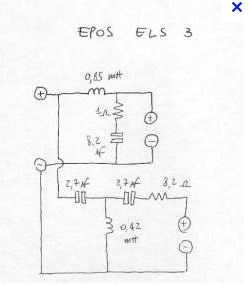
But that circuit is for a 4 ohm bass as it goes.
For an 8 ohm bass circuit, 1mH and 10uF is not a bad place to start. But 1.8mH and 6.8uF is an option. Gets to a similar place, but less peaky at 3kHz crossover. You often add some small resistance to the 6.8uF parallel capacitor shunt to align phase.
My estimate was a simple series coil and parallel shunt capacitor is all you need here. But time will tell.
What is hard about integrating a couple of flattish and low inductance 3" fullrangers with 3/4" 4 ohm tweeter?
It is going to look like this with an added 2.2R resistor right next to the tweeter to get the 4 ohm tweeter up to 6 ohms:
I showed you a typical way you to up a tweeters resistance:
But that circuit is for a 4 ohm bass as it goes.
For an 8 ohm bass circuit, 1mH and 10uF is not a bad place to start. But 1.8mH and 6.8uF is an option. Gets to a similar place, but less peaky at 3kHz crossover. You often add some small resistance to the 6.8uF parallel capacitor shunt to align phase.
My estimate was a simple series coil and parallel shunt capacitor is all you need here. But time will tell.
Its not that im making it more complicated than it is, at least i dont mean too, i just dont understand enough to know what is good and what is bad, you mentioned phase was wrong, but i dont know why, and you mentioned that the tweeter inductor was too small, again, i dont know why that matters. I made this thread to try to learn the correct way to do it as i want to do the best i can on these speakers even though they are cheap in comparison to others. Adding the resistor ito the tweeter circuit did indeed raise the impedance to 6ohms, so thank you for that, but with regards to the rest of the circuit, it gives a descent response but the crossover point is too low, and the only thing that moves it is a lower inductor value. Now i dont know if that is due to the way i did my measurements or if its something else, ill add all those values again tonight and upload the graphs, if you wouldnt mind checking them as i may have made a mistake on the connections or placement of the parts?
Im literally at the most basic level when it comes to circuits and how they affect the sound, but i am trying my best to learn
Im literally at the most basic level when it comes to circuits and how they affect the sound, but i am trying my best to learn
Ive just added the component values from the photo above, the impedance is bang on, i now know how to adjust the impedance for tweeters so i appreciate your help with that, but the response doesnt seem great when i add all of the other values. When i invert the tweeter i dont get much of a dip at the crossover point either, but saying that the crossover point is around 2000hz lower than i would like, ill mess about with it some more though. And i apologize if ive misunderstood your instructions in the earlier post.
Can you please explain to me why the inductor on the tweeter being too small was an issue? Just so i can avoid the same mistake in future
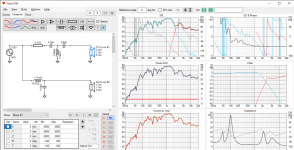
Can you please explain to me why the inductor on the tweeter being too small was an issue? Just so i can avoid the same mistake in future

I would try a 1.8mH coil here with 6.8uF parallel to the bass.
And put a 2.2R next to the tweeter. We are trying to avoid the 4 ohm tweeter filter.
You should have plenty of tweeter level to play with!
FWIW, my MarkAudio CHN-50 fullrangers arrived today! 😀
Wish I had 4, then I could twin them up like my Logitech computer Z200 speakers.
And put a 2.2R next to the tweeter. We are trying to avoid the 4 ohm tweeter filter.
You should have plenty of tweeter level to play with!
FWIW, my MarkAudio CHN-50 fullrangers arrived today! 😀
Wish I had 4, then I could twin them up like my Logitech computer Z200 speakers.
Attachments
So im not sure if i understood you correctly, i didnt know if you meant to replace the inductor and capacitor values of the ones already in the circuit or to add another pair, hopefully ive done it right. But this way the impedance is good, its just the response thats a little out of whack and also the cross point. I dont know what im doing wrong tbh, i may re take all my measurements again because the fall on the tweeter just doesnt look right to me. Anyways i had to go back to xsim just for now because i cant figure out how to find the z offset in vituix, even though i know its 0.7 in xsim i dont know how to convert that into the correct number on the other software yet.
heres the snapshots, i can upload the actual file if you would find it easier to change the values in xsim yourself and tell me if it seems to adjust the response as it should when a component is added?
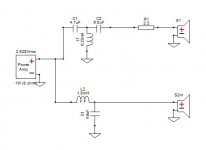
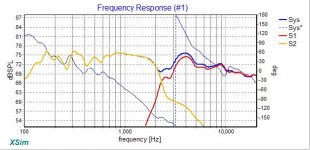
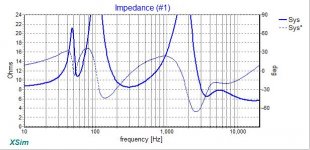
Those drivers look nice, what do you have planned for them?
heres the snapshots, i can upload the actual file if you would find it easier to change the values in xsim yourself and tell me if it seems to adjust the response as it should when a component is added?



Those drivers look nice, what do you have planned for them?
- Home
- Loudspeakers
- Multi-Way
- Trying to finish my mtm style speakers
